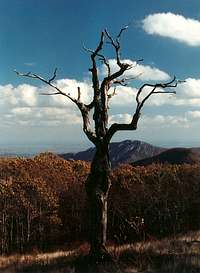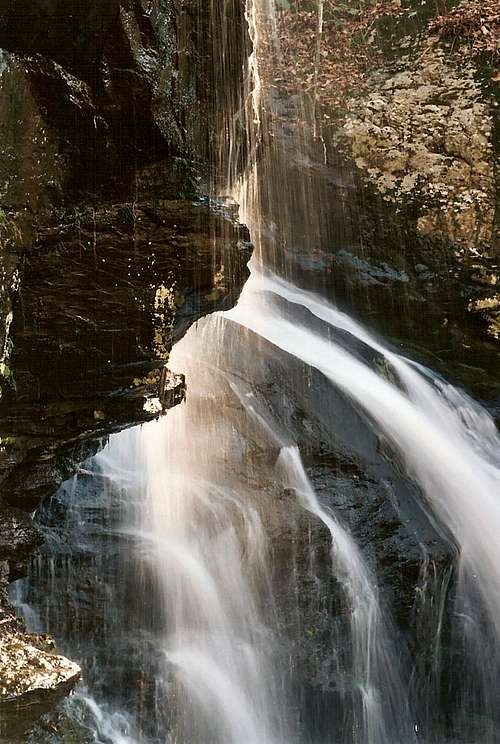Blue Ridge Beauty
The mountain parks of the East cannot compare even closely to those of the West in terms of spectacular scenery, but they do have their own charm. Shenandoah is the park closest to me, and I have spent more time there than I have in all other national parks combined. I have seen many of its faces and moods and all of its seasons, and I find something else to love or remember each time I go. It is also where I got my start hiking and climbing, and it is the site of many of my formative outdoors experiences.
Shenandoah has revealed many of its secrets to me, but I will never discover all or even most of them. With this album, I pay sincere but nevertheless insufficient tribute to Shenandoah, and I appreciate the opportunity to share the beauty of the park with all who visit this page.
My Favorite Dead Tree
I once saw this tree, alive, in a photo collection from the 1930s. When it died, I don't know, but I do know it finally fell in early 2001 during an ice storm. For almost six years, it was my favorite photographic subject in the park. Its remnants are still there. And so are my memories of it. Long may they be.
A Park Overview
There is no way I can claim to have the time or the knowledge to write comprehensively and authoritatively about all there is to see in the various parts of this very long mountain system. Instead, this and the following two sections will take you on a tour of sorts through the parts of the range I know best, and the trip will cover well over 400 miles.
Shenandoah National Park—- If there weren’t already a page covering the mountains of this park, I would make one myself, and it would become almost an endless project for me, so often and extensively have I hiked and climbed in the park and seen so many of its faces and moods and secrets. To get detailed information about specific Shenandoah mountains, go to the park page here, to which this page is attached. But to learn a little about this narrow and most-protected part of the Blue Ridge, please read on.
![Lower Doyles River Falls]() Lower Doyles River Falls
Lower Doyles River Falls
For the most part, Shenandoah National Park consists of a long ridge system only a few miles wide and the slopes and valleys, “hollows,” adjacent to the ridges. North to south, the park is more than 100 miles in length, longer than most other national parks, even many of those in the West, but it is rarely more than ten miles wide, which is narrower than most other national parks. Still, Shenandoah is a gem and a wilderness island amid a sea of development whose shores creep closer by the day, it seems. Hidden among its mossy, fern-clad forests are streams and waterfalls, cliffs, rocky outcrops both quiet and crowded, wildlife ranging in size from black bears to almost-microscopic insects, riotous wildflowers, virgin stands of trees, and ruins of old homesteads and cemeteries.
Shenandoah is divided into three contiguous districts—- North, Central, and South. All have paved access. The Central District is the highest and has the greatest concentration of highly scenic trails, the North is the busiest, and the South is the wildest and quietest. Meandering along or near the crest of the Blue Ridge all the way is Skyline Drive, one of the prettiest roads in the East; in autumn when the leaves change color and in certain periods of the spring when showy flowers like mountain laurel and trillium bloom profusely, it is one of the prettiest roads in the entire country. Winter is my favorite season there, though; huge icicles hang from roadside cliffs, ice coats the waterfalls’ edges and sometimes covers them entirely, the leafless trees allow better views of mountainsides and from trails, and visitation is light—- in fact, the park often seems empty.
![Sulphur on Heliotrope]() Sulphur on Heliotrope
Sulphur on Heliotrope
Where to begin to see Shenandoah? For purposes of this page, I will limit myself to locations right off or close to Skyline Drive, the means by which most visitors see the park, anyway. In the North District, which begins outside the town of Front Royal, the cliffs at Big Devils Stairs are nice, and the more adventurous can take a lightly maintained trail down into the canyon there and return via the stream, where there is a small, secluded waterfall. The Jeremy’s Run Trail, at the Elkwallow picnic area, follows one of the park’s prettiest streams deep into one of its broadest areas.
In the Central District, try Whiteoak Canyon (page attached), which, though crowded, is many a visitor’s choice for the most beautiful trail in the park. Hiking the entire canyon will take one past six major waterfalls and several lesser ones, and returning via Cedar Run will mean seeing at least three more. Some of the park’s largest and oldest trees are in this area, and the spring wildflowers here are gorgeous; visits during successive weeks will reveal different bloom concentrations and types each time. Just north of Whiteoak Canyon is the easy trail to Stony Man Mountain’s summit, where one may see peregrine falcons. Along the way are the Little Stony Man Cliffs, where there is technical climbing for free soloists and rope users alike. A few miles south of Whiteoak Canyon is the short, steep trail to the summit of Hawksbill, the park’s highest peak. Skip Dark Hollow Falls Trail, which leads to a pretty waterfall but is just too crowded to be enjoyable, except in winter—- when the only sign of company may be animal tracks in the snow. Near the end of the Central District is the trail to South River Falls, where the plunging creek hits a tier, splits around a large rock, and then drops as two parallel cascades the rest of the way.
The South District offers some great deep backcountry opportunities. Perhaps the finest is the Doyles River-Jones Run loop, doable (and usually done) as a day hike but nicer as an overnighter. This loop passes through stands of huge trees and by three large waterfalls, but there are many other cascades and pools that will delight hikers. Another fine loop is the Wildcat Ridge-Riprap system, which heads deep into the park’s wilder and wider west side. People really looking for solitude but wanting a good trail system should head into the Big Run area, which is deep wilderness for the East. The South District ends at Rockfish Gap, where the Blue Ridge Parkway begins.
![Autumn Gold]() Autumn Gold
Autumn Gold










Comments
Post a Comment